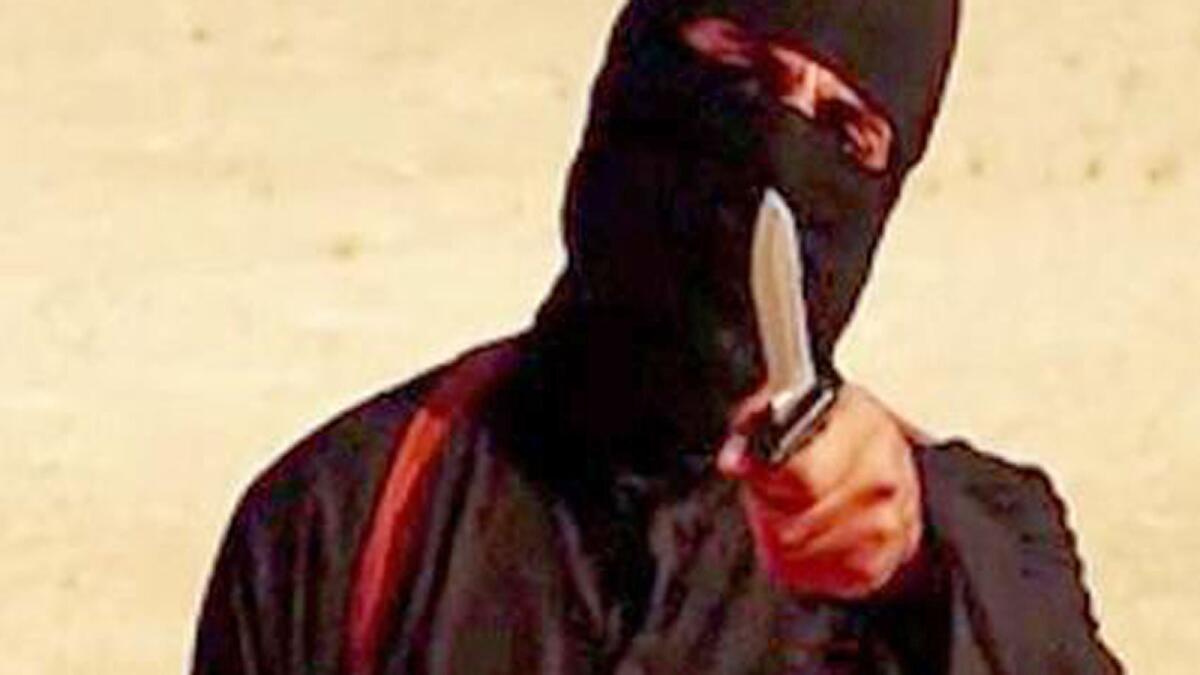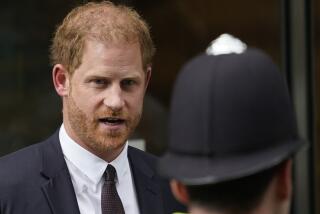Transformation of ‘Jihadi John’ -- from quiet Briton to suspected killer

The knife-wielding militant who appears in a string of grisly beheading videos, his face concealed by a black balaclava and speaking in British-accented English, has come to personify the brutality of the extremist group Islamic State.
Nicknamed “Jihadi John” in the world’s media, he was unmasked Thursday as Mohammed Emwazi, who is in his mid-20s and was born in Kuwait and raised in West London, and studied computer programming at the University of Westminster.
The apparent transformation of Emwazi — described as a man who once had been kind and soft-spoken — into the face of ruthless extremism raised new questions about the allure of Islamic State and Britain’s role as an incubator of Islamist militancy.
Emwazi had apparently been on the radar of British authorities for years before he left for Syria around 2013.
The revelation of his identity marks Emwazi as the latest in a string of homegrown British radicals:
-- In December 2001, British-born Richard Reid boarded an American Airlines flight from Paris to Miami with explosives hidden in his shoes, which he tried unsuccessfully to detonate.
-- In July 2005, four suicide bombers struck the London underground system and a bus, killing 52 people and injuring more than 700.
-- The following year, police foiled a plot to use liquid explosives to blow up seven airliners flying from Britain to the United States and Canada; eight British residents were convicted for their roles.
Such incidents have led to stepped-up counter-terrorism efforts, including the more aggressive pursuit of known radicals whom authorities had previously allowed to operate comparatively freely in hopes of winning them over or gleaning valuable intelligence.
Police credit the new approach with averting four or five suspected terrorist plots in 2014 and at least one a year for several years before that.
But an advocacy group that assists British Muslims in trouble with the security services suggested Thursday that authorities’ heavy-handed approach to Emwazi may have driven him into the arms of Islamic State.
“The Mohammed I knew was extremely kind, extremely gentle, extremely soft-spoken,” CAGE research director Asim Qureshi told reporters, a description dramatically at odds with the violence portrayed in Islamic State propaganda and recounted by the group’s former hostages.
Qureshi said Emwazi first contacted CAGE when he was detained in Tanzania with two friends in the summer of 2009 and sent back to Britain, interrupting what he said was a vacation after completing his studies.
Suspected of attempting to join the Somali militant group Shabab, Emwazi was repeatedly questioned by British security officers, who on one occasion, he alleged, threw him against a wall, grabbed at his beard and choked him. Officers with MI5, Britain’s domestic intelligence agency, also asked Emwazi whether he was willing to become an informant, Qureshi said.
The attention of the British authorities later prevented Emwazi from moving to Kuwait, where he said he had a job waiting, and cost him two fiancees, Qureshi said.
“I wish that things could have turned out differently for him and for many other people,” Qureshi said. “When are we going to finally learn that when we treat people as outsiders they will feel like outsiders and they will look for belonging elsewhere?”
The British government and security services declined to discuss the claims, but an organization familiar with Emwazi’s case disputed CAGE’s version of Emwazi’s radicalization.
Haras Rafiq, managing director of the Quilliam Foundation, which was founded by former militants to counter the recruiting efforts of Islamist extremists, said it had evidence that Emwazi was involved with a network of people whose movements were restricted because of links to the Shabab.
“MI5 does not intervene unless they have evidence,” Rafiq said. He declined to elaborate.
Investigators interviewed former hostages and used voice analysis to help identify the man in the beheading videos, who has been known to British authorities for several months, according to a Western official in Washington who spoke on the condition of anonymity to discuss internal assessments.
The news of Emwazi’s identity was first reported by the Washington Post and BBC, and confirmed to The Times by the Western official, who said the suspect’s name had been kept secret to help intelligence officials better track his communications and movements.
The Obama administration refused to confirm the reports. National Security Council spokeswoman Bernadette Meehan said she could not comment on current investigations and was therefore not in a position to confirm or deny the identity of the man in the beheading videos.
“As the president has said, no matter how long it takes, the United States will not rest until we find and hold accountable the terrorists who are responsible for the murders of our citizens,” she said in a statement.
Shiraz Maher, a senior fellow at the International Center for the Study of Radicalization at King’s College London, said the identification of Emwazi was a reminder that radicalization is not principally driven by poverty or social deprivation.
“He is middle class and well educated, which chimes with a lot of our research,” Maher wrote in an essay for BBC. “Indeed, the overwhelming majority of British individuals who go to Syria are from high-achieving backgrounds.”
At least 600 British nationals are believed to have gone to Syria, according to figures released by British defense officials. But British lawmaker Khalid Mahmood, who sits on an all-party committee on terrorism, has said the figure could be as high as 2,000.
Rafiq said the strategy devised for dealing with extremism was supposed to have two prongs. While going after suspects believed to pose an immediate danger, attempts were to be made to work with mentors within Muslim communities to dissuade those who had merely expressed sympathy with extremist ideology from acting on their beliefs. But he said the second part of the strategy has been neglected in recent years.
“We stopped doing the basics, the real prevention work,” he said. The government is “just looking at this problem through the eyes of legislation and criminality.”
Plainclothes police officers visited the modest brick row house in West London where Emwazi’s family is believed to have lived, the BBC reported. But neighbors said they had not seen the occupants in days, nor Emwazi for several years.
According to CAGE, Emwazi moved to Kuwait after his forced return from Tanzania, and worked there for a time as a computer programmer.
He returned to Britain twice in 2010 to visit his family, the organization said. But when he tried to go back to the Persian Gulf nation the second time, he was not allowed to board his flight and was later informed that his visa had been rejected.
“I had a job waiting for me and [a] marriage to get started,” he later wrote in a police complaint, excerpts of which were released by CAGE. “But know [sic] I feel like a prisoner, only not in a cage, in London. A person in-prisoned [sic] & controlled by security service men, stopping me from living my new life in my birthplace, & my country, Kuwait.”
Qureshi said Emwazi tried repeatedly to clear his name with the help of CAGE and his parents. In what Qureshi described as a final desperate attempt to get back to Kuwait, Emwzai legally changed his name in 2013 to Mohammed al-Ayan and bought another ticket. He was again barred from traveling and questioned by security services.
A week later, Emwazi left his parents’ home and did not return. Four months after the family reported him missing, police informed them that he was believed to be in Syria.
Emwazi’s family is still not convinced that their son is the man in the beheading videos, saying many questions remain about what happened after he left Britain, Qureshi said.
Jihadi John first appeared in a video showing the beheading of American journalist James Foley in August. He was later seen in other videos that showed the slayings of U.S. journalist Steven Sotloff, British aid worker David Haines, British taxi driver Alan Henning and U.S. aid worker Peter Kassig.
The fact that the purported Islamic State executioner was apparently born in Kuwait — liberated from Iraqi hands in the 1991 Persian Gulf War by a U.S.-led military coalition — adds to the monarchy’s infamous roster of terrorists who have attacked U.S. and other targets.
Kuwait, a U.S. ally, has also been a key source of private funding for extremist groups fighting in Syria, authorities say.
Kuwait was the birthplace of Khalid Shaikh Mohammed, the self-confessed mastermind of the Sept. 11, 2001, attacks, and his nephew Ramzi Yousef, an architect of the 1993 car-bomb strike on New York’s World Trade Center that killed six and injured hundreds, but was meant to topple both towers and cause mass casualties. Mohammed and Yousef were born to Pakistani parents.
Mohammed is being held at the U.S. lockup at Guantanamo Bay, Cuba, and Yousef is serving a life sentence at a U.S. high-security prison in Florence, Colo.
Special correspondent Boyle reported from London and Times staff writer Zavis from Los Angeles. Staff writers Brian Bennett in Washington and Patrick J. McDonnell in Sana, Yemen, contributed to this report.
For more international news, follow @alexzavis on Twitter.
More to Read
Start your day right
Sign up for Essential California for news, features and recommendations from the L.A. Times and beyond in your inbox six days a week.
You may occasionally receive promotional content from the Los Angeles Times.







